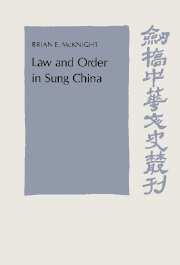Book contents
- Frontmatter
- Contents
- List of figures, maps, and tables
- Preface
- List of abbreviations
- 1 Introduction
- 2 The historical context
- 3 Crimes and criminals
- 4 Informal and semiformal agencies of law enforcement
- 5 Formal civil agencies of law enforcement
- 6 The role of the military in law enforcement
- 7 Supervision of law enforcement – the role of the intendants
- 8 Personnel selection
- 9 Urban crime and urban security
- 10 The Sung penal system
- 11 Jails and jailers in the Sung
- 12 Penal registration
- 13 The death penalty
- 14 Modifications of penalties
- 15 Conclusion
- Glossary
- Bibliography
- Index
10 - The Sung penal system
Published online by Cambridge University Press: 23 December 2009
- Frontmatter
- Contents
- List of figures, maps, and tables
- Preface
- List of abbreviations
- 1 Introduction
- 2 The historical context
- 3 Crimes and criminals
- 4 Informal and semiformal agencies of law enforcement
- 5 Formal civil agencies of law enforcement
- 6 The role of the military in law enforcement
- 7 Supervision of law enforcement – the role of the intendants
- 8 Personnel selection
- 9 Urban crime and urban security
- 10 The Sung penal system
- 11 Jails and jailers in the Sung
- 12 Penal registration
- 13 The death penalty
- 14 Modifications of penalties
- 15 Conclusion
- Glossary
- Bibliography
- Index
Summary
Introduction – functions of penalties
The product of an effectively functioning law-enforcement system is captured suspected criminals, but this product is merely a means to a further end, the reduction to a tolerable level of socially threatening deviance. Insofar as the presence of law-enforcement agents actually discourages the commission of crimes, it directly contributes to the larger goal. The captured criminals pose a different problem: Assuming that they are found guilty, how should they then be treated? What sort of treatment will contribute most to the general aim of creating a society not threatened by serious deviance? More exactly, given the array of options that the ruling group can envision as both possible and acceptable, and within the constraints set by organizational skills, technology, fiscal limitations, and competing state goals, what responses will be most useful? For the majority of those captured and convicted, this comes down to the question of how they are to be punished. The answers given in a specific culture are bounded in part by contemporaries' visions of their own past history; in trying to understand their own time they look at the evolution from their cultural past to the present.
The levels of punishment exacted in traditional China reflected a vision of the past and how the current practices evolved, the ideas of state leaders about the uses of penalties, and a perception of the current historical situation. Penalties are seen as useful in both internal and external terms. Internally, they might create a more stable and peaceful society. By reflection the resulting good order helps in the competition with external enemies.
- Type
- Chapter
- Information
- Law and Order in Sung China , pp. 321 - 352Publisher: Cambridge University PressPrint publication year: 1992

